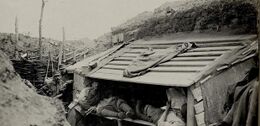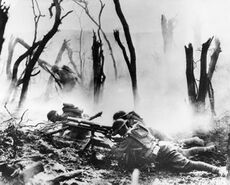Great War (Aurorum)
This article is incomplete because it is pending further input from participants, or it is a work-in-progress by one author. Please comment on this article's talk page to share your input, comments and questions. Note: To contribute to this article, you may need to seek help from the author(s) of this page. |
| Great War | |||||||
|---|---|---|---|---|---|---|---|
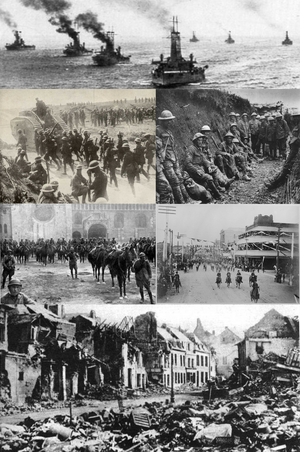 (Clockwise from the top)
| |||||||
| |||||||
| Belligerents | |||||||
|
X |
X | ||||||
| Commanders and leaders | |||||||
|
|
| ||||||
| Strength | |||||||
|
Total: 3,920,294 |
Total: 10,023,000 | ||||||
| Casualties and losses | |||||||
|
Military dead: 495,204 Military deaths by country |
Military dead: 1,736,852 Military deaths by country | ||||||
The Great War, also known as the Great Berean War or the World War, was a significant global conflict primarily between nations in Siantria and Telmeria in Berea and overseas in Caphtora and Pamira, that lasted from 1910 to 1916. Having reached a never before seen scale, it led to the mobilisation of more than 20 million military personnel, making it one of the largest wars ever fought. With an estimated three million combatants and one million civilian deaths as a direct consequence of the war, it is also one of the deadliest conflicts in history. The conflict began on September 7, 1911 following X. It lasted until the unilateral surrender of remaining X powers on May 29, 1916 and peace was declared following the Treaty of Lehpold in early 1917.
TBD
The Continental War at large was a political, economic, cultural, and social turning point for the world. it is generally considered to mark an end to the age of colonial empires in Berea, and saw the dissolution of multiple influential states and the deterioration of others' powers. The war and its immediate aftermath saw a number of revolutions and uprisings in Dulebia, Cuthland, Mascylla, and X. Through the political instability, the Big Three (Albeinland, Lavaria and Mascylla; the principal X members and war victors) emerged their power as great powers and imposed their demands on the defeated enemies in a treaty drafted and signed in 1917—the Treaty of Lehpold. Ultimately, the intergovernmental organisation of the Assembly of Nations was founded to spearhead international cooperation and to prevent another large-scale conflict.
Background
| Events leading to the Great War | ||||||||||||||||||||||||
|---|---|---|---|---|---|---|---|---|---|---|---|---|---|---|---|---|---|---|---|---|---|---|---|---|
 | ||||||||||||||||||||||||
|
||||||||||||||||||||||||
Political atmosphere and ambitions
Arms race
Tensions in Berea
Prelude
The war
Dulebian and Cuthish ambitions for Rovina
Western Front
Dulebian offensive and entrenchment
The armed conflict in the west between the Dulebian and Lavarian armies began on 25 September 1911, 15 days after the declared full mobilization of Dulebian forces. According to the Dulebian pre-war plan, Operation XX, more commonly known as Operation Rassvet, the Dulebian army was almost entirely stationed on the Lavarian border, with the bulk of the forces situated to the south on the Volynsk plain. The Dulebian command left its northern flank relatively weakened, and planned to use the river Lena as a natural barrier and defence frontier. This positioning of the Dulebian forces was used to lure the Lavarian forces to attack on that part of the front, leaving the south mostly undefended against the main Dulebian advance.
The Dulebian right flang was ordered to retreat towards Lena on 26-28 September, this retreat was followed by a Lavarian attack, as planned by the Dulebians. Then, on 29 September, the Dulebian offensive was launched on the left flank by the 2nd Field Army of General Kuznetsov and 3rd Field Army of General Bakunin. The two armies met severe Lavarian resistance on the river Lena, where the Lavarians constructed a fort near the town of Granita. The siege of Granita was the first major battle of the campaign, and slowed the Dulebian advance by two days, giving time for Lavarian command to form new army in the south and march it to the Dulebian border. Simultaniously with the armies of Kuznetsov and Bakunin, 4th Field army under Birulyov, originally kept as reserve to protect the southern frontiers of Dulebia against possible intervention from the Gurkhan empire, was ordered to cross the Lavarian border and attack the Lavarian reinforcements marching from the south, protecting the left flank of 2nd and 3rd armies. The advance of Bakunin and Kuznetsov was halted near the city of Montalvia; the Dulebian forces, who managed to march almost 120 km into Lavaria in less than a week, overstretched their supply lines and the soldiers were exhausted from the rapid advance. The communication lines of the Dulebian forces have not been established. However, the Lavarian forces already started to regroup and a significant portion of their armies were stationed near Montalvia. Facing the risk to lose momentum, Bakunin ordered his forces to cross river Montalvia and mit the Lavarians head-on without reinforcements or an established supply chain. In the resulting Battle of Montalvia, Dulebia faced the first major defeat in the campaign, and its advance was stalled.
Following the Dulebian defeat at Montalvia, the Gurkhan empire, which remained neutral since the start of the war, declared war on Dulebia and invaded the Muromo-Pomorsk Kingdom on 4 March, meeting almost no resistance as all Dulebian forces were sent to the Western front. These events forced the Dulebian command to stop all advances and initiate a regrouping of its forces. General Milyukov, commander of the 1st army on the Dulebian right flank, who sat in defence behind Lena since the start of the campaign, was ordered to attack and push towards Aniarro as it was believed the Lavarian presense there was limited after the regrouping of Lavarian forces near Montalvia. At the same time, 2nd army of Kuznetsov, which already managed to establish stable supply chain, received orders to turn north and connect with Milyukov, attempting encirclement of the Lavarian forces between Bakunin's 3rd army and the Karsk sea coast. Lavarian forces attempted a similar maneuver to encircle the advancing forces of Milyukov. As both forces raced towards the Karsk sea, they had to leave significant amount of forces on the newly-forming frontlines in order to protect their flanks from possible encirclement attempts by their opponent. As a result of this operation, the frontline was stretched even further and in the end it was stalled; both Lavaria and Dulebia found themselves in a stalemate and began entrenching to preserve their current positions.
Summer offensive of 1912 and the frontline stall

Bakunin's offensive and the Dulebian revolution
Dulebian cruiser hunters
Karsk sea
Eastern Theatre
Northern Front
Cuthish advances
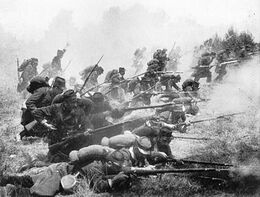
The Northern Front was one of the main theatres of war during the Great War. Following the outbreak of war in September 1910, the Cuthish army opened the Northern Front by first invading the cities of Bad Ülerst and Saarow, which prompted the Mascyllary Kingdom to hastily muster their defences without prior tactical decisionmaking. Therefore, the Cuthish was able to penetrate Mascyllary defences at their border and sweep into the Fanian Plain, quickly gaining military control over important industrial regions in Mascylla. The First Battle of Augusthal proved to be the backbone of any further advances and the obliteration of large-scale Mascyllary military resistance for half a year.
With too little forces set up in time and a chaotic retreat as a result, Mascylla suffered heavy territorial losses in the first months and year of the war. Having reached an unbearable toll on Mascyllary morale and resources, government officials began demanding for a peace truce. However, the tide was turned dramatically in the Battle of Lückwalde and by pure chance with the destaster at Marienfelde where a large portion of the Cuthish forces were swiftly wiped out and saving Königsreh in the process. With Mascylla beginning to hold ground against Cuthland, the front now established between Pereuth on the coast of the White Sea to Konreid at Lake Sigismund began to solidify, despite costly efforts by both sides to lift the stalemate. Furthermore, numerous attempts to open a second front in southern Gothia remained ineffective.
By the end of 1911, the opposing forces were left confronting each other along an uninterrupted line of entrenched positions in central Mascylla. Since the Cuthish were able to choose where to stand, they normally had the advantage of the high ground; in addition, their trenches tended to be better built, since Mascyllary trenches were initially intended as "temporary," preparatory to breaking the Cuthish defences.
Trench warfare and progress of the war
Between 1913 and 1914 several offensives along this front were tried. The attacks employed massive artillery bombardments and waves of infantry divisions. Entrenchments, machine gun emplacements, barbed wire and artillery repeatedly inflicted severe casualties during attacks and counter-attacks and no significant advances were made. Among the most costly of these offensives were the Second Battle of Augusthal, in autumn of 1913, with a combined 600,000 casualties (estimated), the Battle of the Rohrn beginning in Summer of 1914, with more than a million casualties (estimated), and the Battle of Seifritz, in 1915/16, with 487,000 casualties (estimated). Gun fire wasn't the only factor taking lives; the diseases that emerged in the trenches were a major killer on both sides. The terrible living conditions were the origin of a number of diseases and health issues as trench foot, shell shock, blindness/burns from mustard gas, lice, trench fever, cooties (body lice) and other.
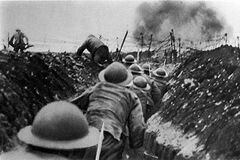
To break the deadlock of trench warfare on the Northern Front, both sides tried new military technology advantages, including poison gas as part of gas warfare, the introduction of military aircraft, and the development of tanks by Mascylla in 1914, essentially contributing to the resolve of trench warfare in the war. The adoption of better tactics and the cumulative weakening of the armies in the west led to the return of mobility in 1916. The Cuthish Storm Offensive, beginning in 1916, led to the devastation of entire regions and further heavy casalties without any advances made, beginning with what is described as a "blunting war". Using short, intense "hurricane" bombardments and infiltration tactics, the Cuthish and Mascyllary armies moved nearly 100 kilometres (60 miles) back and forth to the west and east, the deepest advance by either side since 1910, but the result was indecisive and very costly on human lifes and material used.
The unstoppable advance of the Mascyllary armies during the Three Months Offensive in 1916 caused a graduating collapse of the Cuthish armies and finally persuaded the Cuthish commanders that defeat was inevitable. During the offensive, Temaria declared its independence, aiding Mascyllary forces as they advanced into Cuthland. The offensive was greatly effective, and by 1916 Mascyllary armies had advanced deeply into Cuthish territory and to the cities of Cingsham and Alderport. The Cuthish government surrendered in the armistics of 29 May 1916, and the terms of peace were settled by the Treaty of Lehpold in 1917.
Southern Front
Early Gurkhan advances
Landings at Balchevsk
Collapse of the Gurkhan empire
Other fronts
Melasia
Nanzhou
Caphtora
Aftermath
Peace treaties and geopolitical changes
Treaty of Lehpold
Main article: Treaty of Lehpold
See also
- ↑ Prior to the Bakunin's Breakthrough in May 1913


